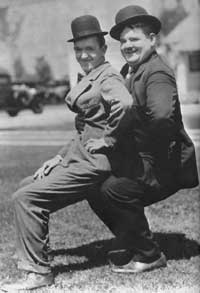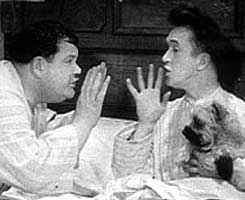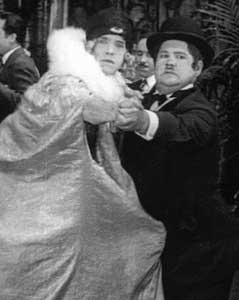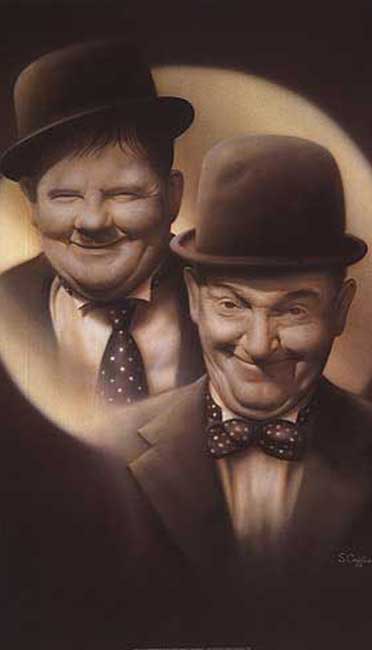Laurel & Hardy's Gay Cinema
 In another forum, the topic of Laurel & Hardy portraying gay characters came up, & a chap named Mark from Quebec piped in: "The Celluloid Closet began as a film series at the American Film Institute over 20 years ago." There was a comment at the time that some Laurel & Hardy films were included in the series because the two were portrayed as friends, & evidently there are those who cannot imagine friendship without a sexual component. Maybe I am naive, but I have shared a bed with a number of men (& a couple of women) without giving a thought to whether someone might assume anything sexual was going on." In another forum, the topic of Laurel & Hardy portraying gay characters came up, & a chap named Mark from Quebec piped in: "The Celluloid Closet began as a film series at the American Film Institute over 20 years ago." There was a comment at the time that some Laurel & Hardy films were included in the series because the two were portrayed as friends, & evidently there are those who cannot imagine friendship without a sexual component. Maybe I am naive, but I have shared a bed with a number of men (& a couple of women) without giving a thought to whether someone might assume anything sexual was going on."
So I provided the following filmfan essay, which I thought worth revising a bit to share here at the Weird Wild Realm:
Mark, you're only naive if you've seen the films & think they're as innocent as all that. You may have slept innocently with a few men & not felt your heterosexuality threatened by it, but did you sleep with those guys every night, cling to their side in every public place, dress up for your bedmate in girl's clothes to pretend to be his wife or maid? Did you make declarations of love to your male bedmates? Stan & Ollie did all those things.
Laurel & Hardy "belong" to "everyone," not just to gays, but they did always have special significance within the gay community. As a comedy duo they intentionally used homosexuality & unorthodox gender behavior for comedy purposes, even more so than the Pythons & vastly more often than most comedians. And they did it in a loving manner rather than offensively, which is what really set them apart.
This lovingness makes them distinct from the Marx Brothers whose more cerebral approach had scarcely even a brotherly love in the performances; or the excrable Stooges who were much more about mutual hatred; or the Ritz brothers who may have been classic sissies but never about affection. The Ritz's could've been the stars of Queer Eye for the Straight Gay but in their day it would've been called Sissy Eyes for the Manly Man. Stan & Laurel could not have been Queer eye stars because in fact the queers of Queer eye attempt never to seem loving but only swishy & campy. It'd be too much if they were fawning on one another as Stan & Ollie do.
 That Stan & Ollie were loving sissies with big hearts & evidently monogamous with one another made them gay icons in days when homosexuality was submerged in cinema. They remain almost revolutionary icons even today, as we're now in a time when entertainment figures can label themselves queers but the on-TV queer kiss is still either taboo or front-page news when it happens (except on cable which even permits porn & so lumps the gay kiss with pornography). Preferably even the avowed queers live semi-hetero lifestyles as idealized by the excrable sitcom Will & Grace. That Stan & Ollie were loving sissies with big hearts & evidently monogamous with one another made them gay icons in days when homosexuality was submerged in cinema. They remain almost revolutionary icons even today, as we're now in a time when entertainment figures can label themselves queers but the on-TV queer kiss is still either taboo or front-page news when it happens (except on cable which even permits porn & so lumps the gay kiss with pornography). Preferably even the avowed queers live semi-hetero lifestyles as idealized by the excrable sitcom Will & Grace.
Stan & Ollie are a lot queerer than Will & Grace, & a lot more about affection than the Queer Eye queers who define themselves by their swishy behavior rather than by love. Indeed those Queer Eye swishes are more like pre-Code sissies than they are like active homosexuals; they are the epitome of unchallenging, unthreatening, sexless stereotypes. By comparison to other of yesteryear's typical sissies or the modern swish equivelants, Stan & Ollie really were revolutionaries.
Freudian analyst Charles Barr considered L & H's "perverse polymorphous childish friendship" not homosexual per se but certainly abnormal. Their friendship was socially retarded in that it was the type of friendship only small children are permitted. Barr diagnosed Stan as a classic case of arrested mental & emotional development. Now I wouldn't personally embrace a Freudian clinical diagnosis of mere comedy, & indeed Barr's diagnosis is the very one that kept homosexuality on the official list of psychiatric disorders until the 1970s, defined specifically as arising from arrested development. It is at least interesting that by retro medical thinking, such relationships as Stan & Ollie's are not & cannot be normal, whether or not sexual.
If we do regard them as the equivalent of five year olds, then in that context, their love for one another is the same as between other preschool children, & they are expressing childhood's innocence from their adult bodies (in one of their films they play actual children, with a set made up of giant furniture to make L & H seem child-sized). But since they are men, not little boys, they cannot legitimately be innocent. Freudians at least will not permit authenticity to the illusion of innocence.
As very intelligent comics they certainly knew it all looked pretty gay. They played into that fact with a marvelous positivity. Russo in The Celluoid Closet called L & H's characterizations (citing especially Their First Mistake, 1932) as "the perfect sissy buddy relationship" with "unmistakably gay overtones" capturing a deeper possibility "of pure androgyny."
Russo also notes that the more outrageous behaviors of cinematic sissies like L & H got clamped down on after the Production Code, & for a while this type of character was not permitted out of Hollywood. The restriction was not because the character-type was innocent of innuendo. The sissy was the original gay figure of cinema, whether it was a coward who leapt on a chair hysterical over a mouse, or Stan bursting into tears over any little thing, or Oliver's exaggerated fussiness at a dinner table. Sissies were ordinarily portrayed sexless because to portray them otherwise would reveal too much; but where L & H are concerned, they sometimes went much further than sexless sissies. They explored even the overt possibilities!
 In Their First Mistake Oliver's wife is jealous of Stan because, as Ollie explains, "She thinks I love you more than I love her." Stan replies, "Well, you do, don't you?" and Ollie says, "Well, we won't go into that." In Their First Mistake Oliver's wife is jealous of Stan because, as Ollie explains, "She thinks I love you more than I love her." Stan replies, "Well, you do, don't you?" and Ollie says, "Well, we won't go into that."
Oliver soon separates from his wife & the lads set up housekeeping together (as they do in several films) & even end up in bed together (as also occurs in many of their films, for they are much closer than best friends who get together several times a week; they are a couple who are constantly together even in their bed, as in Their First Mistake, They Go Boom (1929) & others.
In several films, Stan crossdresses & sometimes becomes flirtatious with Oliver. Oliver occasionally attempts to enter into a more normal marital bliss, but if he does, Stan will destroy Ollie's house, as in Helpmates (1932), "helpmates" being a biblicalism for married couple; or interfere with Ollie's wedding, as in Our Wife (1931), or welcome Ollie back from his failed attempt to go straight, as in Beau Hunks (1931).
In That's My Wife (1929), Stan gets to become Mrs. Hardy herself. In Babes in Toyland (1934) Stan plays Little Bo Peep & gets to be a bride. In Me & My Pal (1933), Ollie forgets to go to his own wedding, he's having so much fun with Stanley. Stan is Ollie's maid Agnes in Another Fine Mess (1930) while in Duck Soup (1927; not the Marx brothers film), Stan's again playing at being Oliver's personal maid. In Sugar Daddies (1927) Stan & Ollie step onto the dancefloor to tango together, Stan in drag.
In Eve's Love Letter (1927) which Stan wrote, he gave himself another reason to be in drag, while in Get 'em Young (1926) Stan becomes a blushing bride (this short also features sissy actor Ernie Wood as "The Lavender Virgin" -- Stan wrote this one himself). Stan's quite a pretty girl in The Sleuth (1925), but is more matronly in Jitterbugs (1943). In Postage Due (1924) he wants a post card portrait of himself as Aphrodite. In Twice Two (1933), the duo play four roles collectively, so that they can also be each others' spouses. There's a book-length study on this aspect of their humor by Jonathan Saunders, called Another Fine Dress (1995).
In Liberty (1929) they become entangled in one another's clothing in the back seat of a taxi & horrified witnesses are convinced they've encountered queers in public sex acts. They do manage to get into each other's pants very literally, then seek out other private places to take their pants off together. The basis of the humor is that they do seem to be just like a couple of park faggots trying to do it in the bushes but always getting caught.
So certainly they at least played, repeatedly, with the expectation of homosexuality, if not the whole deal. What Stan & Ollie definitely were were gender nonconformists who challenged the enforced norms of masculinity. If anyone in real life actually behaved in that manner, they would be assumed to be gay, & in 99.9% of cases that assumption would be correct. So gay icons they remain, even though they can be iconic in many another context too.
copyright © by Paghat the Ratgirl
|



